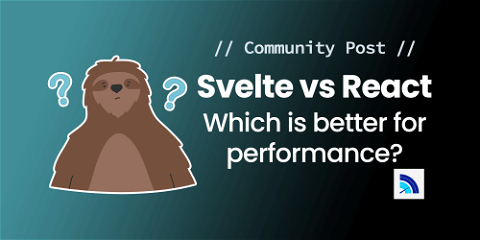
Svelte vs. React: Which is Better for Performance?
You can hardly even talk about web development without mentioning JavaScript. Because of its popularity, JavaScript has given birth to several frameworks and libraries that developers can barely keep up with. This post will discuss two popular JavaScript front-end frameworks and libraries: Svelte vs React and their performance. We’ll determine if Svelte is faster than React or whether Svelte is better than React. We’ll also compare the two to determine which is better for performance.
Svelte and React are the two most popular frameworks used to create web applications. We’ll compare the strengths of each and break down the features that make each framework unique and how they handle common situations in development.
What is Svelte?
Svelte is a framework that enables developers to build UIs using self-emitting components. It’s highly modular and fully customizable thanks to the Markdown-like template language it uses. Since Svelte is lightweight, it can run on any device that supports a JavaScript runtime environment, such as Node.js. Like React, Svelte has predictable rendering properties and provides functional stateless components.
Svelte is an open-source JavaScript library that implements server-side rendering. It aims to be a more lightweight framework, so it focuses solely on speed and performance and an extremely simple API. At its most fundamental level, Svelte allows developers to focus solely on building user interfaces without worrying about the complexities of implementing JavaScript and gives them countless tools for accomplishing their tasks.
What is React?
React is a JavaScript library conceived and developed by Facebook to give front-end developers something new to experiment with. React gave birth to a new way to deal with front-end development. It aimed to give developers a way to create user interfaces more quickly and easily using JavaScript.
The core of React is its component model. In React, the term “component” refers to a software code snippet designed to do just one thing. It can be a text box, a drop-down menu, or anything else on an HTML page. All components are reusable, which makes them more versatile than regular HTML elements and richer than typical CSS classes.
React provides highly customizable components and a virtual DOM that allows for fast incremental rendering of changes instead of a full page refresh when you make changes, which means faster loading.
Svelte vs React: Which Is Better?
We can’t compare the two libraries without knowing their key points and attributes. This article compares them based on the following:
- Server-side rendering
- Render time
- Utility component library size
- Initial render
React vs Svelte: Server-Side Rendering Comparison
React-based applications can benefit from server-side rendering by handling the JavaScript components on the client with a headless browser or server (such as Node.js). Server-side rendering allows for more efficient concurrent DOM updates, which improves performance. This is the main difference between React and Svelte. React is initially faster, but Svelte updates changes with a smaller footprint.
Svelte, being server-side rendered, only needs to be run on the server for static hosting rather than for every request. It doesn’t need to create new components as it does with other frameworks, and it can handle any type of change through code splitting. React-based applications, on the other hand, can be used in either method. It’s more versatile where render time speedup comes into play.
Svelte vs React: Render Time Comparison
React is useful for building large component-heavy applications and large applications, whereas Svelte is helpful for large single-page applications. React can only render small components that are hosted statically, but Svelte cannot. It needs to be built for every request.
Svelte’s compiler also includes optimizations similar to React’s virtual DOM trees. It automates as much logic as possible and pre-calculates values for attributes and styles, optimizing rendering speed by making fewer DOM calls and ensuring more consistent output. Svelte’s custom build tool allows the app to be bundled into a single file with all dependencies preloaded to run in any browser supporting WebAssembly. It also offers incremental builds that incrementally recompile only what has changed rather than the entire application every time.
The main difference between the two libraries is their render time speedup since they handle various scenarios differently. React is faster at initial renders, but Svelte is faster at updating changes.
Unlike React, Svelte has no virtual DOM. Thus, it’s even faster because it won’t do any re-renders when using non-mutating data.
Svelte vs React: Utility Library Size Comparison
Regarding size comparison, React has a relatively large code size since it requires additional libraries like react-dom to run on the server. Svelte does not include any extra dependencies except the core library, so its size is smaller and thus faster. When you have CPU-intensive applications, you’ll have to consider the bundle size, where gzipped React is 42.2KB, while Svelte is 1.6KB.
React vs Svelte: Performance
We know Svelte for its efficient performance. It creates high-performance JavaScript applications by compiling its source code into highly optimized components and applying immutable updates to the actual DOM when needed. The framework is especially well suited for mobile applications as it needs only tiny amounts of memory for each component.
React uses virtual DOM trees on the front end to update the real DOM and efficiently manage state transitions. Developers can use the Webpack plugin to compile their app and package it as a standalone JavaScript bundle that can be served from any page of their web application with one HTTP request per page.
In a high-performance application, you’ll want to take the time to get it right. In React and Svelte, development focuses on creating components that do more with less code. The two libraries have specific optimizations in mind when designing their components based on different patterns used in real-world applications.
React focuses on creating reusable components for everyday tasks and increasing performance efficiency. React is also optimized for user interaction and animations when using them together with WebSockets.
Svelte focuses on creating single-page applications (SPAs) with a clean design. It also doesn’t need too much code. The components it contains and how it interacts with the DOM define a typical Svelte application.
If performance is a priority, React may be the better choice because of its focus on reusable components and integration with WebSockets.
React vs. Svelte: Which Is the Best for you?
React and Svelte are similar, but some key differences make each unique. If you want to build a simple web application or an app that needs to be built quickly that doesn’t have many resources (typically used on a smaller scale), then it would be best to go with Svelte. This is because of the smaller file sizes and faster load times. However, suppose you’re building a more enhanced application that requires a great deal of interaction between the UI and the back end (for example, sending data to and from the API) or has other requirements (for example, a data-driven application). In that case, you should probably go with React.
You can build your applications with many tools, but which you should choose depends on your needs. React is certainly a great option, as is Svelte. Take the time to learn how to use them both, and you will build applications that are easier for you to maintain and use in the future. And while you’re at it, you can take advantage of Request Metrics to track and monitor your web performance.
This post was written by Mercy Kibet. Mercy is a full-stack developer with a knack for learning and writing about new and intriguing tech stacks.


